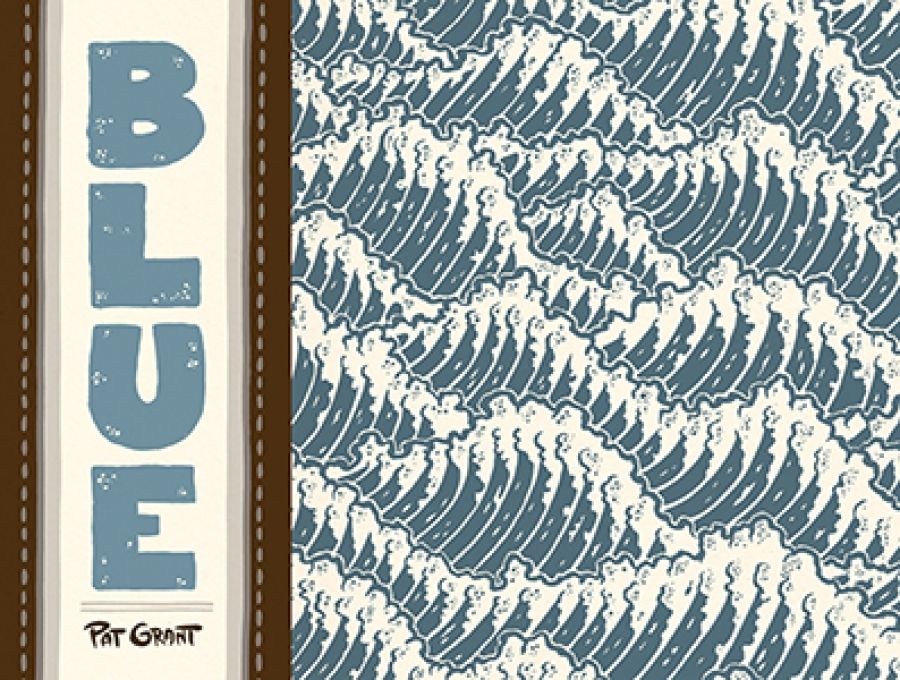
- Free Article: No
- Contents Category: Graphic Novel
- Custom Article Title: Ronnie Scott reviews 'Blue' by Pat Grant
- Review Article: Yes
- Online Only: No
- Custom Highlight Text:
The Australian graphic novel, being a fairly new phenomenon, has no unifying aesthetic, no identifiable form. While it is possible to group the characteristics of French, American, and Japanese comics, Australia’s finest exponents are stylistically on their own. Nicki Greenberg crafts adult work from a child’s figurative toolkit, Shaun Tan’s comics are drenched in high fantasy draftsmanship, and Eddie Campbell still operates with the New Wave gumption that swept the comics world of 1980s Britain. Each artist addresses Australia in his or her own fashion, and there is no risk of Australian comics developing their own miniature genres: an equivalent to our inner-city grunge literature, for example, or to the steely, rangy ‘red dust’ short story.
- Book 1 Title: Blue
- Book 1 Biblio: Giramondo/Top Shelf, $20 hb, 96 pp
But Pat Grant’s début graphic novel, Blue, is both thrillingly, unmistakably Australian and a powerful artistic statement. Grant has told interviewers that he stopped drinking for a year so that he could think more clearly, compose more logically, and draw more finely throughout its creation. Blue matches its ambition to a confident form, and seems likely to influence a generation of local doodlers who are beginning to experiment with ink and brush.
Blue is about small-town social dynamics, the queasiness that accompanies demographic shifts, and the bittersweet fog that can distort our memories of childhood. The setting, Bolton, a 1989 Tidy Towns Winner, is wholly fictional, but it is filled with details endemic to all Australian beach towns. There is the greasy fish and chippery, for instance, complete with schnitzels and Chiko Rolls. As for social history, Grant’s narrator nails it in one sentence: ‘What could be more appealing to a couple of hardworking bogans than a whole town that smelled like fresh white paint?’
Decades on, the town is overrun by blue people. The blue people look different from the ratbag kids haunting the narrator’s half-remembered Bolton: their tentacles have the same rubbery, unpredictable fluidity as the noodles they are always slurping down. Not helping matters is the fact that the blue people also have bottomless black eyes, suggesting sadness, deep historical damage, or simply an alien unknown.
 A page from 'Blue'
A page from 'Blue'
Blue, which covers a day in the life of three young truants, begins when they encounter their first blue person on the street. ‘They’re from some other country. Like, near Africa,’ one child explains. They embark on a journey along a disused set of train tracks, having learned that somewhere along those tracks lies the body of a blue person. Here, the narrative is influenced by the 1986 coming-of-age movie Stand By Me, which is itself adapted from Stephen King’s novella The Body (1982). As with Stand By Me, the children walk along a set of train tracks towards a dead person, and the risk of the journey is that their innocence will be lost. But the children’s dialogue is also seasoned with salty Australianisms – all gammons, nahs, and youzes – and a peculiarly Australian political disquiet lurches behind the journey that Grant, at savvy moments, pushes to the fore.
Blue has entered the world under an usual publishing model. Grant has self-published in conjunction with a quality US comics publisher and a respected Australian literary press; the book is also freely available online. The hardcover edition is a gorgeous piece of bookmaking. It concludes with a well-researched essay, ‘Genealogy of the Boofhead: Images, Memory and Australian Surf Comics’, wherein Grant points out an alternative history of Australian comics that has escaped popular and critical attention. Overall, Blue is both an evocation and an interrogation of nostalgia, told by an artist who is well in control of mood and allegory.


Comments powered by CComment